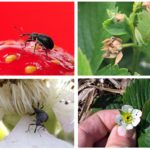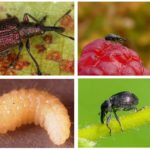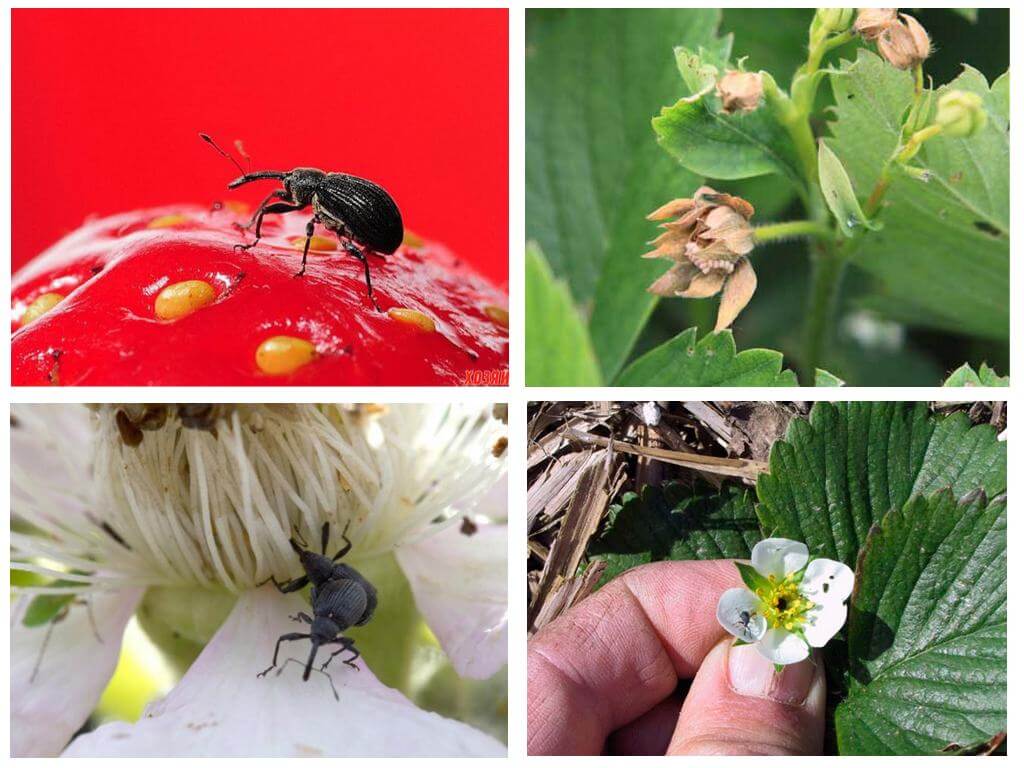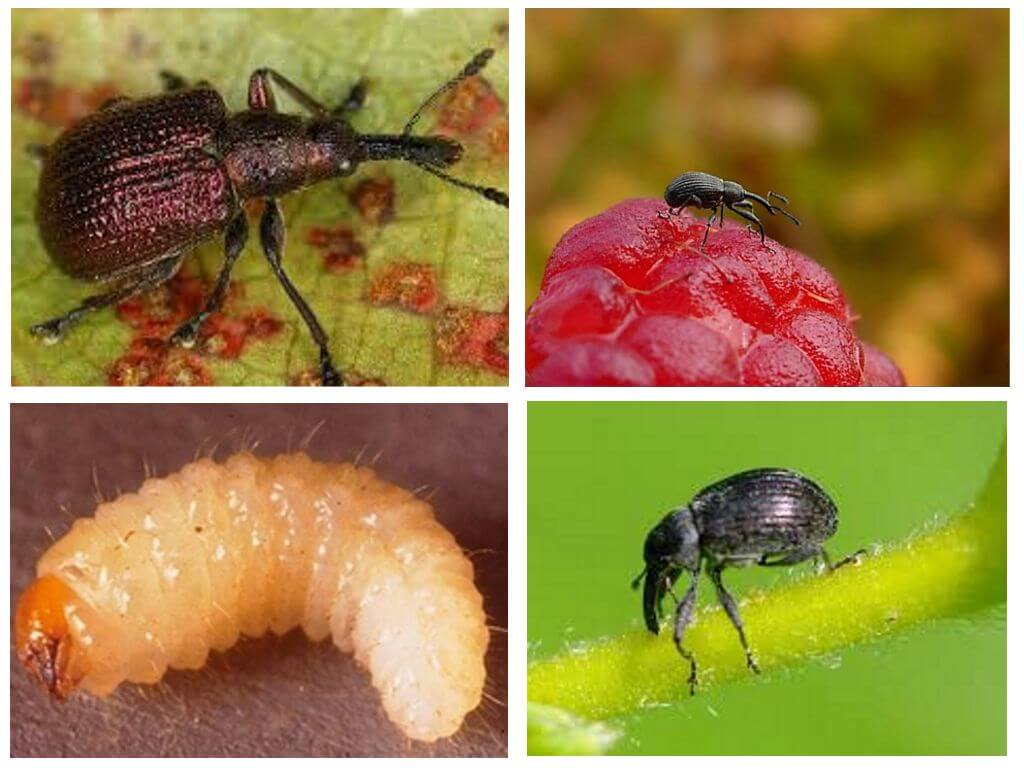Strawberry weevil
Content
- Strawberry weevil
- Strawberry Weevil Larvae
- Plants from strawberry weevil
- Preparations from strawberry weevil
Strawberry weevil or tsvetoed does great harm to berry crops.In addition to raspberries and strawberries, he feels great on blackberries, strawberries and other wild herbaceous plants of the Rosaceae family. Approximately 90% of the yield of tender berries is lost due to the fact that the pest destroys the buds of flowering plants.
Meet a garden pest
The raspberry-strawberry weevil lives everywhere, where strawberries and raspberries grow. Agricultural pest has a black color. Its small oval body, reaching a length of 2-3 mm, is covered with small setae of gray color. The small head is extended in long proboscis and is supplied with club-shaped antennae, consisting of seven segments. Hard elytra has poorly visible grooves.
Experienced gardeners and beginners lovers are interested in the question, to which order does the strawberry weevil belong? The pest belongs to the order of beetles of the family weevils. Immature insects overwinter in last year’s plant remains, under fallen leaves and in other secluded places. With the onset of spring, when the soil warms up to about 13 ° C, they begin to leave their wintering grounds.Determine what feeds crimson pest, is not difficult. At this time, strawberries begin to grow, which is a favorite food for beetles. They gnaw through the young shoots of the crop through, and with the appearance of the first buds, damage them and feed on immature anthers.
Breeding
Approximately a month after the active saturation of strawberry weevils, reaching puberty, go to the process of mating. The female begins to lay eggs from mid-May, and this period lasts for a month.
Initially, beetles place masonry on flowering strawberries. Weevil pierces the bud from the side and lays one egg in it. Then it seals the hole with excrement and gnaws on the pedicle prudently. A few days later the buds turn brown and fall off. An embryo located inside develops within seven days. Due to the short period of strawberry budding, weevil-beetle moves to its later varieties, and then to raspberries, blackberries and strawberries.
Interesting!
The damage inflicted on only one female is estimated at fifty damaged buds of the tender berry.
Seven days later, without legs, dirty-gray curved larvae with a yellow-brown head appear from the eggs, which are capable of bringing great damage to berry crops. They feed on buds. Here they pupate. If this part of the plant is not on the ground, the larvae die. The development of the pupa takes from seven to nine days. The young strawberry-raspberry weevil appears in mid-July and begins to be actively saturated with young leaves of strawberries, raspberries, as well as their late ovary and unripe green berries. When the air temperature drops to 10-12 ° C, they go to the winter, hiding in the upper layers of the soil or under fallen leaves.
Depending on weather conditions, the duration of the whole period of formation of young individuals can last from 25 to 45 days. The strawberry weevil in the photo posted on the site will allow you to become familiar with the pest and the main phases of its development.
Signs of a malicious beetle in the garden
The main symptoms indicating the presence of weevils on berry crops include the following characteristic phenomena:
- small-diameter holes or punctures in the early foliage of strawberries;
- brownish buds of berry culture;
- a large number of fallen, like cut inflorescences;
- on bushes you can see the buds that are full and hanging on a dried foot.
The presence of at least one of these phenomena indicates that the strawberry weevil has settled in the garden plot
Protective and preventive measures against beetles
In order to save the planting of strawberries, raspberries and other berry crops from the voracious beetle, care should be taken to create unfavorable conditions for its existence on the site. Experienced gardeners recommend such protective measures:
- regularly dig up the aisles to destroy the beetles hiding for the winter;
- prevent thick, uncoupled areas;
- update the planting raspberries and strawberries, removing old plantations;
- periodically inspect the planting and shake off crawling raspberry weevils, until the end of the harvest;
- if possible, plant early varieties of strawberries and strawberries;
- raspberry weevil does not tolerate sharp odors of Chernobrivtsy, lily of the valley, nasturtium and garlic, so they can be planted next to the berry;
- clean up and burn all garden garbage in spring and autumn;
- damaged shoots and leaves to destroy;
- try to attract in the garden of natural enemies of the weevil ground beetles, which are capable of destroying up to twenty-five beetles each day.
These and other preventive control measures will reduce the risk of contamination of the garden plot with dangerous agricultural crimson pests.
Radical weevil control
If all preventive measures have not brought the expected result and the beetle continues to host the garden, then it is necessary to move on to more effective means of destroying the pest. The fight against strawberry weevil involves the use of chemicals or safe folk remedies. To obtain the maximum effect, you need to know at what time to carry out processing plants. Fighting the beetle must begin when the pedicels have already formed and have risen, but the buds have not yet become isolated. At this time, there is the highest concentration of insects on berry crops, and they are available for a variety of drugs.
Folk recommendations
The raspberry weevil can be destroyed with solutions prepared using the means available to everyone. Well proven such recipes:
- infusions of tobacco, garlic, mustard or soap are used during the formation of buds;
- decoction of walnut leaves is used for spraying plants before flowering;
- wormwood solution is recommended to cultivate the bushes and the land under plantings;
- the infusion of capsicum gives a good result, but requires strict adherence to proportions;
- decoction of tansy with the addition of soap.
These recipes make up a small part of the tools that gardeners use to kill beetles.
Chemicals
How to deal with weevils with insecticides, detailed in the instructions for each drug. Manufacturers recommend using a large number of different preparations for processing berries. Protect raspberry bushes from weevil and save the harvest will help:
- Kemiphos;
- Fufanon nova;
- Spark M;
- Novaktion;
- Fitoderm;
- Agravertine.
For spraying strawberries most often used:
- Fufanon;
- Kemiphos;
- Alatar;
- Inta-vir.
Knowing where the strawberry weevil lives, it is necessary to thoroughly process all the berry plantations in accordance with the recommendations set out in the instructions.













